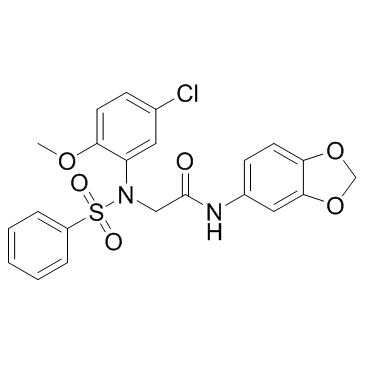333745-53-2
| Name | LX2343 |
|---|---|
| Synonyms | N-1,3-Benzodioxol-5-yl-N2-(5-chloro-2-methoxyphenyl)-N2-(phenylsulfonyl)glycinamide |
| Description | LX2343 is a BACE1 enzyme inhibitor with an IC50 value of 11.43±0.36 μM. LX2343 acts as a non-ATP competitive PI3K inhibitor with an IC50 of 15.99±3.23 μM. LX2343 stimulates autophagy in its promotion of Aβ clearance. |
|---|---|
| Related Catalog | |
| Target |
BACE1:11.43 μM (IC50) PI3K:15.99 μM (IC50) Aβ Autophagy |
| In Vitro | LX2343 (5-20 μM) dose-dependently decreased Aβ accumulation in HEK293-APPsw and CHO-APP cells, and promotes Aβ clearance in SH-SY5Y cells and primary astrocytes. LX2343 ameliorates cognitive dysfunction in APP/PS1 transgenic mice via both Aβ production inhibition and clearance promotion, which highlights the potential of LX2343 in the treatment of AD. Western blot results in both HEK293-APPsw cells and CHO-APP cells demonstrate that LX2343 fails to regulate BACE1 protein levels, while in vitro BACE1 enzymatic activity assays indicated that LX2343 dose-dependently decreases BACE1 activity (TDC as a positive control) with an IC50 of 11.43±0.36 μM. To test whether competition exists between LX2343 and ATP, we investigated the effects of ATP at different concentrations on the inhibitory activity of LX2343. The result demonstrated that the inhibition of LX2343 against PI3K is virtually unaffected by ATP. Thus, this result suggested that LX2343 is a non-ATP competitive inhibitor of PI3K. In the presence of 10 μM of ATP, the IC50 of LX2343 is 13.11±1.47 μM, in the presence of 50 μM ATP, the IC50 of LX2343 is 13.86±1.12 μM, in the presence of 100 μM ATP, the IC50 of LX2343 is 15.99±3.23 μM [1]. |
| In Vivo | APP/PS1 mice express chimeric human Swedish mutant APP and a mutant human presenilin 1 protein and are widely used as an effective animal model for AD dementia. The amelioration of memory impairment by LX2343 is evaluated t in this model using the MWM test. In 8-d training trials, the path lengths and escape latencies used to find the platform for APP/PS1 transgenic mice are remarkably longer than those for non-transgenic mice, while 10 mg/kg LX2343 administration obviously antagonizes the prolonged path lengths and escape latencies at d 7 and 8. In the probe trial assay, the LX2343-administered transgenic mice cross over the hidden location of the platform more frequently compared with the vehicle-administered transgenic mice[1]. |
| Kinase Assay | Inhibition of BACE1 enzyme by LX2343 is assayed using BACE1 activity kits in vitro. Briefly, BACE1 substrate (250 nM), BACE1 enzyme (0.35 U/mL), and varied concentrations of LX2343 (5, 10, and 20 μM) are sequentially incubated for 1 h at 37°C in the dark. Fluorescence intensity is measured with excitation and emission wavelengths at 545 and 585 nm, respectively[1]. |
| Cell Assay | SH-SY5Y cells are transfected with mRFP-GFP-LC3 plasmids via an adenovirus. The cells are treated without or with Streptozotocin (0.8 mM) in combination with 5 or 20 μM LX2343 for 4 h and then fixed with 4% paraformaldehyde and observed using an Olympus Fluoview FV1000 confocal microscope[1]. |
| Animal Admin | Mice[1] APP/PS1 [B6C3-Tg(APPswe, PS1dE9)] transgenic mice are used. Genotyping to confirm APP/PS1 DNA sequences in their offspring is performed by assaying the DNA from tail biopsies, with Tg-negative mice as a negative control. Twenty male APP/PS1 mice are divided into two groups with ten non-transgenic mice in one group to serve as a negative control. The two 6-month transgenic groups are administered 10 mg/kg per day of LX2343 or vehicle, and the 6-month non-transgenic group is administered the vehicle for 100 d via intraperitoneal injection. After 100 d of administration, MWM assays are applied to evaluate the cognitive abilities of the mice for 8 d under continuous LX2343 treatment. Upon completion of the MWM test, the mice are euthanized, and the brains are removed and bisected at the mid-sagittal plane. The right hemispheres are frozen and stored at -80°C, and the left hemispheres are fixed in 4% paraformaldehyde[1]. |
| References |
| Density | 1.5±0.1 g/cm3 |
|---|---|
| Molecular Formula | C22H19ClN2O6S |
| Molecular Weight | 474.914 |
| Exact Mass | 474.065247 |
| LogP | 3.28 |
| Index of Refraction | 1.663 |
| Storage condition | 2-8℃ |
